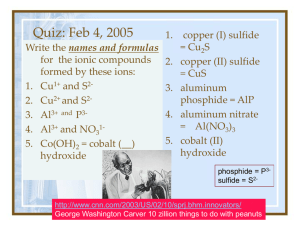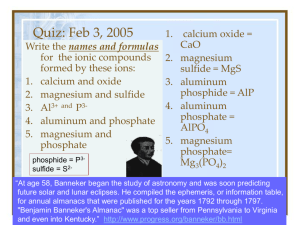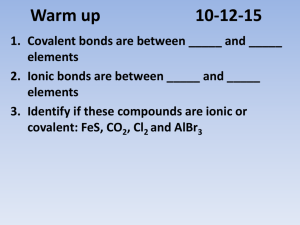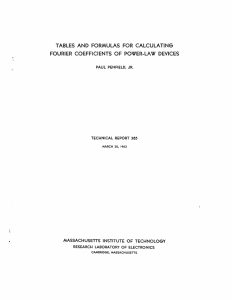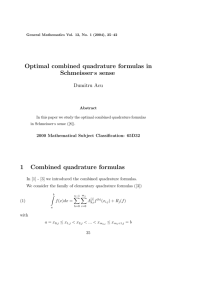CovalentMolecPres
advertisement
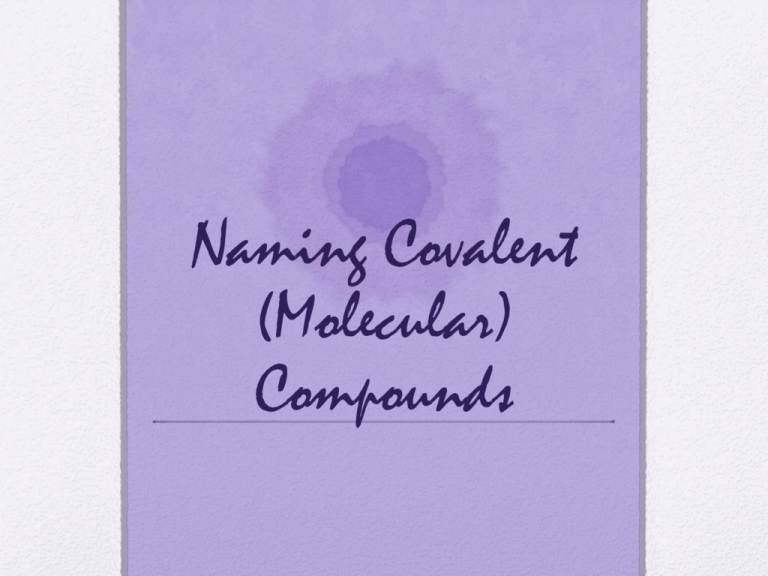
Naming Covalent (Molecular) Compounds Properties of Covalently Bonded Compounds • Usually TWO NONMETALS bonded together • Two nonmetals share electrons between them • Can be Gases, Liquids or “squishy” solids. • Generally have LOW melting and boiling points • Do not conduct electricity well • Usually not very soluble in water How are covalent compounds different than Ionic ones? Ionic Covalent • Metal – Nonmetal bond • Nonmetal-Nonmetal bond • Electrons are transferred • Electrons are shared • Generally solid • Solid, Liquid or gas • High Melting/Boiling pts • Low Melting/Boiling pts • Conduct electricity when melted or dissolved • Do not conduct What is the basic structural unit of a covalent compound? • Covalent compounds form MOLECULES • Bonding between atoms in a molecule is generally much, much stronger than the attraction between different molecules. • Married couples analogy… How are covalent compounds different than Ionic ones? Ionic • Basic Structural unit is the “Unit cell” or the “formula unit” • Ions arranged in crystal structure Covalent • Basic structural unit is the MOLECULE • Molecules may attract each other but that attraction is small compared with internal bonding Naming molecules from their formulas Use the Prefixes… 1 – mono 2 – Di 3 – Tri 4 – Tetr(a) 5 – Pent(a) 6 – Hex(a) 7 – Hept(a) 8 – Oct(a) 9 – Non(a) 10 – Dec(a) • CO2 • N2O • B2H6 • CH4 • NH3 Naming molecules from their formulas Use the Prefixes… 1 – mono 2 – Di 3 – Tri 4 – Tetr(a) 5 – Pent(a) 6 – Hex(a) 7 – Hept(a) 8 – Oct(a) 9 – Non(a) 10 – Dec(a) • CO2 carbon dioxide • N2O dinitrogen monoxide • B2H6 diboron hexahydride • CH4 carbon tetrahydride commonly known as “Methane” • NH3 nitrogen trihydride commonly known as “Ammonia” Writing formulas for molecules from their names Use the Prefixes… 1 – mono 2 – Di 3 – Tri 4 – Tetr(a) 5 – Pent(a) 6 – Hex(a) 7 – Hept(a) 8 – Oct(a) 9 – Non(a) 10 – Dec(a) • Carbon monoxide • Sulfur trioxide • Silicon tetrachloride • Diphosphorus pentachloride • Tetraphosphorus triselenide Writing formulas for molecules from their names Use the Prefixes… 1 – mono 2 – Di 3 – Tri 4 – Tetr(a) 5 – Pent(a) 6 – Hex(a) 7 – Hept(a) 8 – Oct(a) 9 – Non(a) 10 – Dec(a) • Carbon monoxide • CO • Sulfur trioxide • SO3 • Silicon tetrachloride • SiCl4 • Diphosphorus pentachloride • P2Cl5 • Tetraphosphorus triselenide • P4Se3 Practice naming and writing formulas Use the Prefixes… 1 – mono 2 – Di 3 – Tri 4 – Tetr(a) 5 – Pent(a) 6 – Hex(a) 7 – Hept(a) 8 – Oct(a) 9 – Non(a) 10 – Dec(a) • WARNING! Some of the compounds listed below are NOT covalent. Make sure you don’t use prefixes when naming them. • Name these compounds: CBr4 , N2O5, MgF2 , SeS , • Write formulas for these: Carbon disulfide, Disilicon hexahydride, Potassium carbonate, Dinitrogen tetroxide
